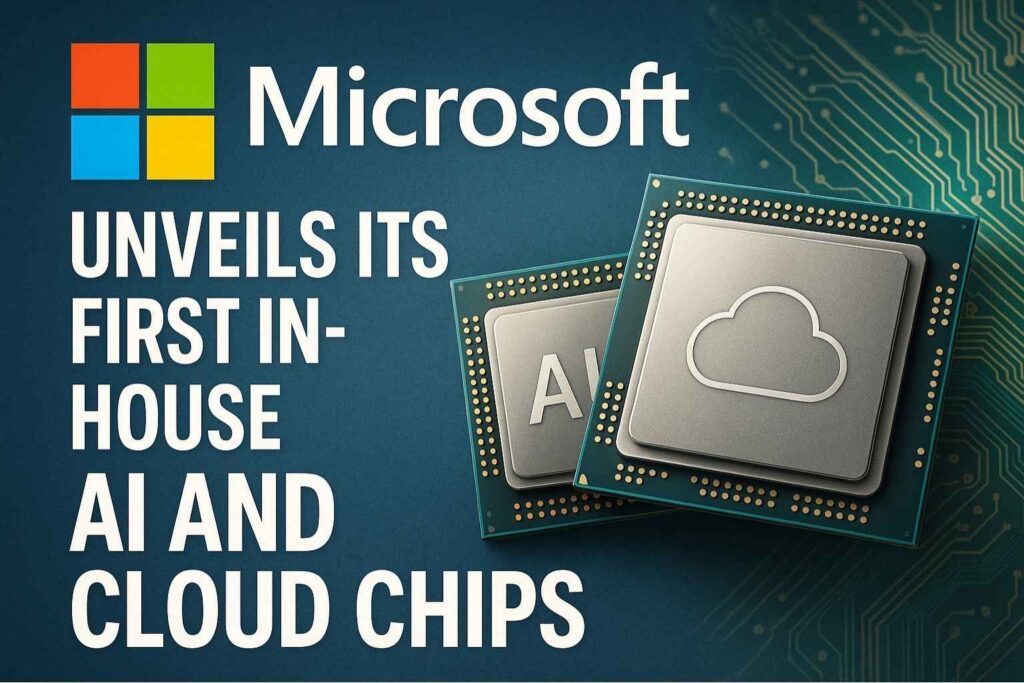For years, Microsoft has leaned heavily on third-party chipmakers like Intel, AMD, and especially Nvidia to power its cloud services and artificial intelligence tools. That reliance worked—until demand for AI skyrocketed. With competition intensifying and supply chains stretched thin, Microsoft decided it was time to take control of its own destiny.
The result is a milestone moment: the debut of Microsoft’s very first in-house microprocessors. These chips are not designed for consumer gadgets but for the backbone of modern computing—data centers, AI models, and cloud services that billions of people touch every day.
Maia 100: The AI Accelerator
The first new chip, called Azure Maia 100, is purpose-built for artificial intelligence. Unlike general-purpose CPUs, this processor is designed to handle the massive workloads of large language models and advanced generative AI applications. Think of services like GitHub Copilot, Bing AI, and Microsoft’s Copilot features across Office—they all rely on vast computing resources.
The Maia 100 is optimized to deliver this power more efficiently. It is built with billions of transistors packed onto a cutting-edge design that allows faster processing of data-heavy AI tasks. By training and fine-tuning it alongside real-world AI workloads, Microsoft ensured that Maia would excel at the exact types of jobs modern AI demands.
Cobalt 100: The Cloud Workhorse
Alongside Maia, Microsoft also introduced the Azure Cobalt 100, a processor focused on cloud computing rather than AI acceleration. This chip is built on Arm architecture and is packed with 128 cores, making it a powerhouse for running everyday cloud services such as Microsoft Teams, Outlook, and Azure SQL databases.
What makes Cobalt stand out is its efficiency. Microsoft claims it offers around a 40% boost in performance-per-watt compared to earlier Arm-based chips running on Azure. In an industry where energy costs are a huge factor, this isn’t just about speed—it’s about sustainability.
Beyond Chips: A Whole System Approach
What sets Microsoft’s move apart is that it didn’t just design the chips and call it a day. Instead, the company built an entire system around them. Custom server boards, new rack designs, and advanced cooling methods were all created to make sure the chips could deliver maximum performance without overheating.
Cooling is a particularly big deal here. Traditional air-based systems are reaching their limits in modern data centers. Microsoft has developed liquid-based cooling techniques that circulate fluid to keep the Maia and Cobalt chips running at full speed. The goal is simple: build a vertically integrated ecosystem where hardware, software, and infrastructure all work together seamlessly.
Why This Move Matters
By creating its own chips, Microsoft joins a select club of tech giants who are no longer fully dependent on outside suppliers. Google has its Tensor Processing Units (TPUs), and Amazon has its Graviton CPUs and Trainium chips. With Maia and Cobalt, Microsoft now has its own homegrown technology to compete in the same league.
This shift is more than just about pride—it’s about cost, control, and long-term resilience. Training and running large-scale AI models is incredibly expensive, and reliance on Nvidia’s GPUs has been both a financial and logistical bottleneck. By using in-house chips tailored for their workloads, Microsoft can reduce costs, avoid bottlenecks, and deliver AI services at scale without waiting in line for limited GPU supplies.
Early Setbacks and Delays
That said, chip development is a complex and unforgiving field. Reports have suggested that Microsoft’s in-house AI chip program has already faced delays, with some designs slipping behind schedule. Compared to Nvidia’s most advanced GPUs, Microsoft’s chips may still fall short in raw performance.
But building processors isn’t about winning on the first try. It’s about iteration, refinement, and learning from mistakes. Microsoft is betting that over the next few years, it can improve its chips, align them tightly with its software stack, and gradually reduce its reliance on outside vendors.
A Glimpse of the Future
These first chips are only the beginning. Microsoft has signaled that Maia will be used to power its AI-driven products, including Copilot and Azure OpenAI services, while Cobalt will become the backbone for much of its cloud computing.
The long-term vision is clear: a future where Microsoft’s cloud runs largely on its own silicon. That means more flexibility to optimize for efficiency, more control over costs, and the ability to move faster in a world where AI demand is growing at an unprecedented pace.
Final Thoughts
Microsoft’s debut of the Maia 100 and Cobalt 100 marks a turning point in the company’s history. By building its own chips, Microsoft is rewriting the rules of how it delivers cloud and AI services. While there are challenges ahead—delays, competition, and performance gaps—the bigger picture is that Microsoft is no longer just a software and services giant. It is now a serious player in the hardware world too.
This strategic move will likely shape the next decade of cloud computing. If successful, it could mean cheaper, faster, and more reliable AI services for businesses and individuals alike. In a race where every second of computing power matters, Microsoft has officially put its own silicon on the starting line.



